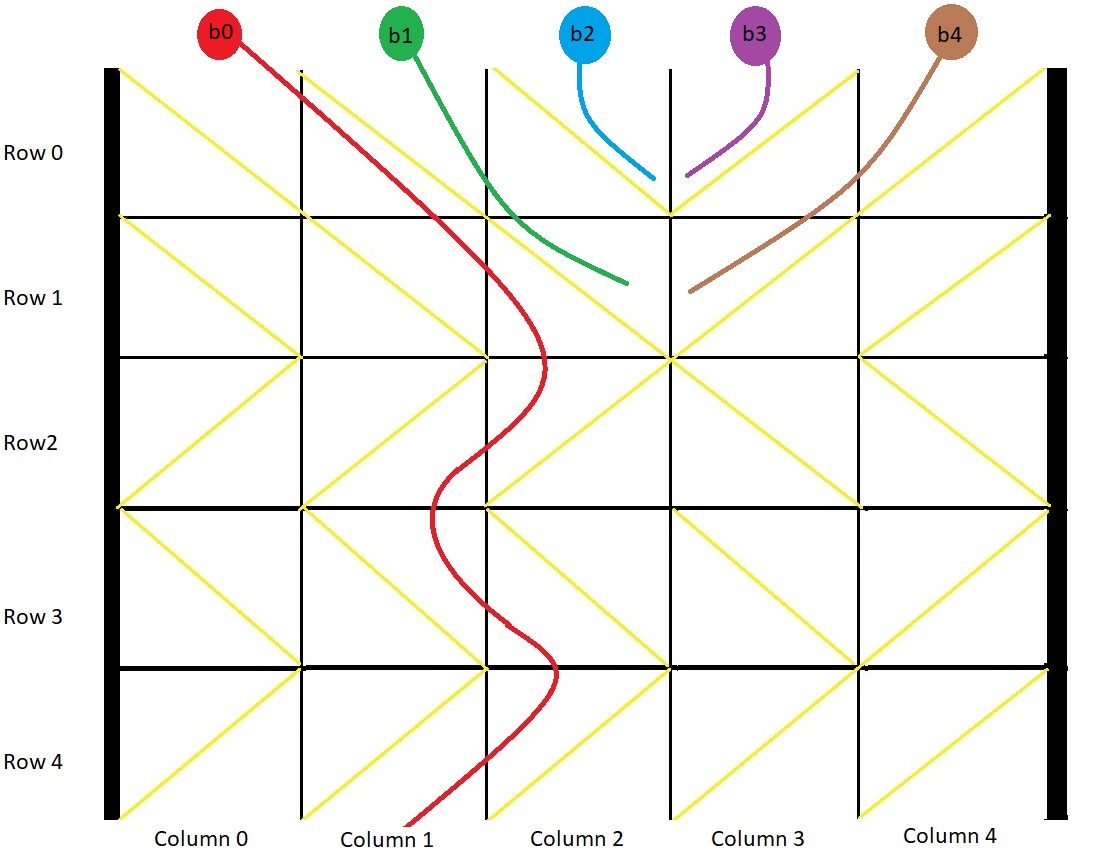You have a 2-D grid of size m x n representing a box, and you have n balls. The box is open on the top and bottom sides.
Each cell in the box has a diagonal board spanning two corners of the cell that can redirect a ball to the right or to the left.
- A board that redirects the ball to the right spans the top-left corner to the bottom-right corner and is represented in the grid as
1. - A board that redirects the ball to the left spans the top-right corner to the bottom-left corner and is represented in the grid as
-1.
We drop one ball at the top of each column of the box.
Each ball can get stuck in the box or fall out of the bottom.
A ball gets stuck if it hits a "V" shaped pattern between two boards or if a board redirects the ball into either wall of the box.
Return an array answer of size n where answer[i] is the column that the ball falls out of at the bottom after dropping the ball from the ith column at the top,
or -1 if the ball gets stuck in the box.
Test Cases

Example 1:
Input: grid = [[1,1,1,-1,-1],[1,1,1,-1,-1],[-1,-1,-1,1,1],[1,1,1,1,-1],[-1,-1,-1,-1,-1]]
Output: [1,-1,-1,-1,-1]
Explanation: This example is shown in the photo.
Ball b0 is dropped at column 0 and falls out of the box at column 1.
Ball b1 is dropped at column 1 and will get stuck in the box between column 2 and 3 and row 1.
Ball b2 is dropped at column 2 and will get stuck on the box between column 2 and 3 and row 0.
Ball b3 is dropped at column 3 and will get stuck on the box between column 2 and 3 and row 0.
Ball b4 is dropped at column 4 and will get stuck on the box between column 2 and 3 and row 1.
Example 2:
Input: grid = [[1,1,1,1,1,1],[-1,-1,-1,-1,-1,-1],[1,1,1,1,1,1],[-1,-1,-1,-1,-1,-1]]
Output: [0,1,2,3,4,-1]
Solution
class Solution {
public:
vector<int> findBall(vector<vector<int>>& grid) {
int n = grid.size(), m = grid[0].size();
vector<int> res;
for(int j=0; j<m; j++) {
int startCol = j;
for(int i=0; i<n; i++) {
int endCol = startCol + grid[i][startCol];
if (endCol < 0 || endCol >= m || grid[i][endCol] != grid[i][startCol]) {
startCol = -1;
break;
}
startCol = endCol;
}
res.push_back(startCol);
}
return res;
}
};class Solution {
public int[] findBall(int[][] grid) {
int n = grid.length, m = grid[0].length;
int[] res = new int[m];
for(int j=0; j<m; j++) {
int startCol = j;
for(int i=0; i<n; i++) {
int endCol = startCol + grid[i][startCol];
if (endCol < 0 || endCol >= m || grid[i][endCol] != grid[i][startCol]) {
startCol = -1;
break;
}
startCol = endCol;
}
res[j] = startCol;
}
return res;
}
}